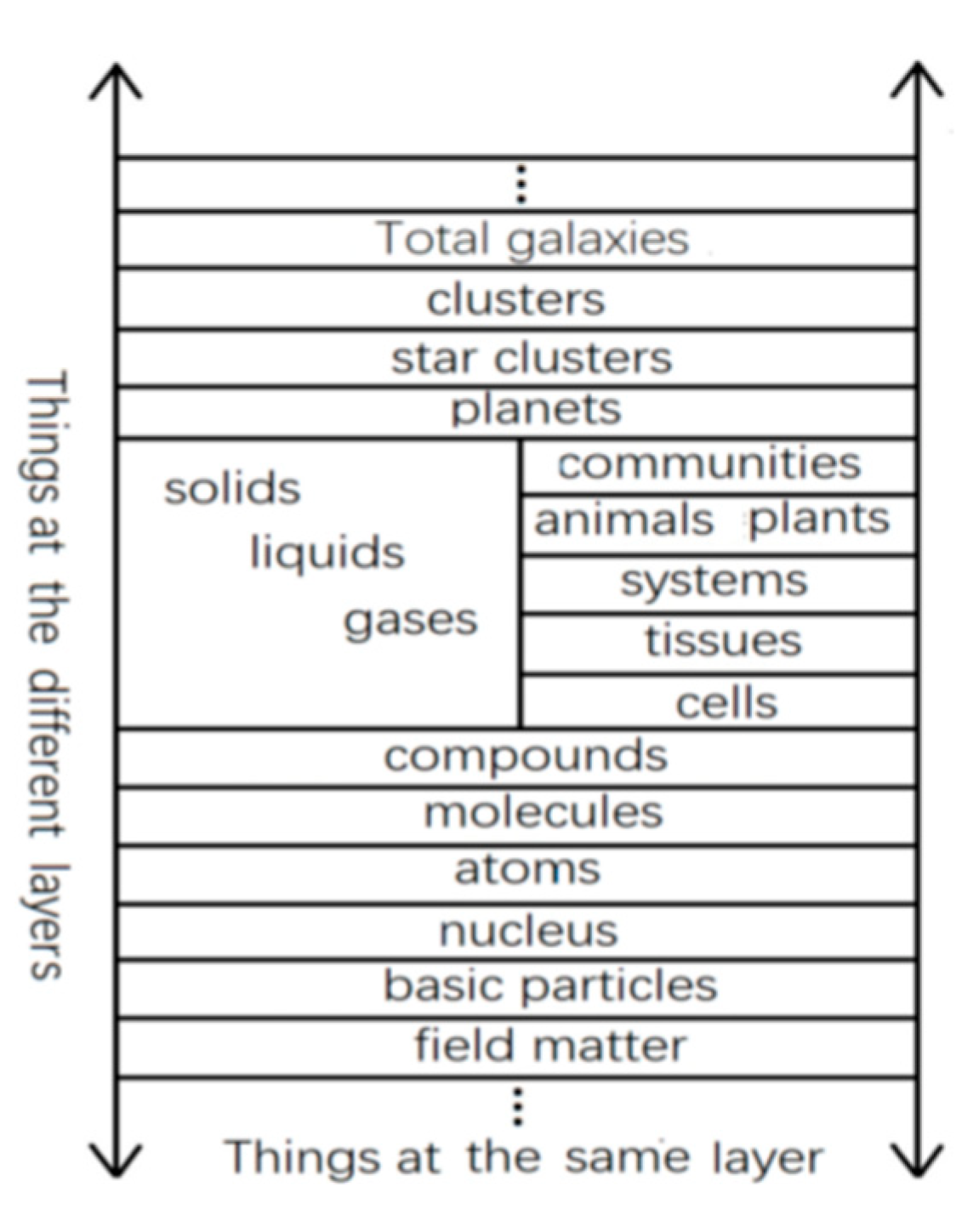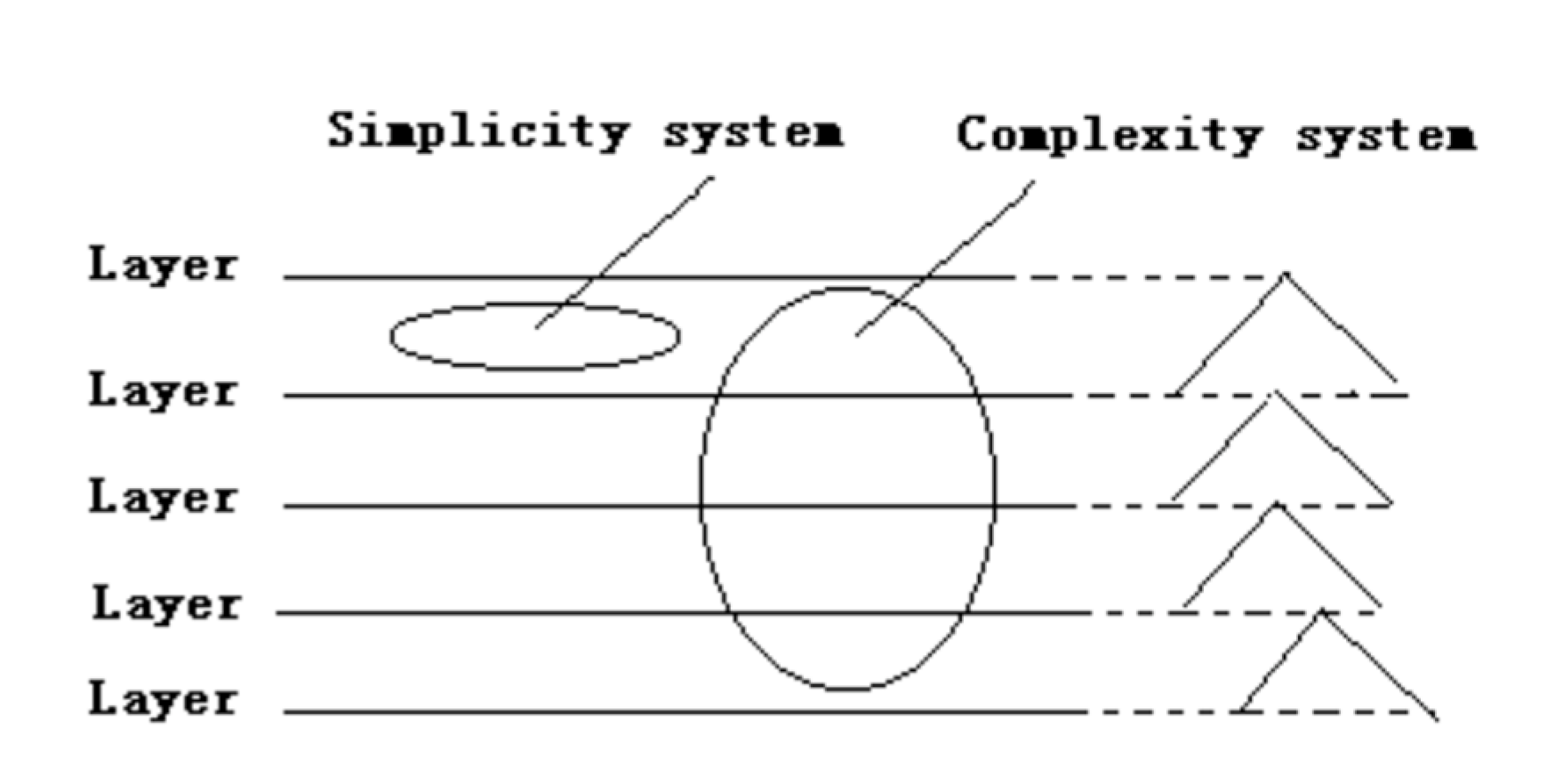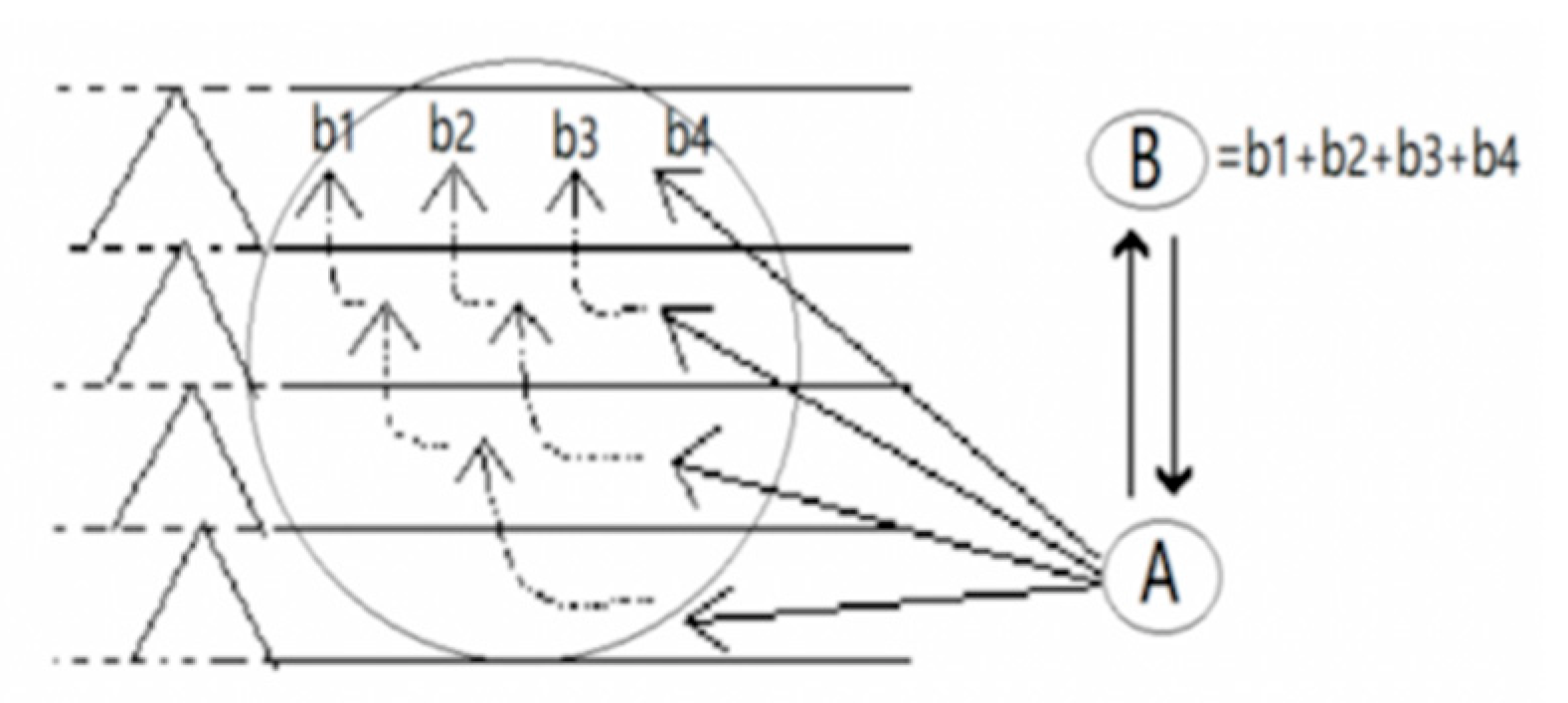1. Introduction
The concept of information has greatly enriched human understanding of the objective world by embodying the ancient understanding of the interaction of how all things exist to a level where it can be quantified and computed. Interaction is no longer an abstract, empty, and arbitrary philosophical category. Information as a concrete form of the interaction of things is an entity. The establishment of the “information entity” allows philosophy and science to understand the world at a new and deeper stage, which plays a huge role in promoting the human practice and prediction of the future, and it affects all aspects of human production and life. Since the 20th century, the development of philosophy and science has, in a sense, benefited from the concept of information and the formation of the concept of information entities, although both concepts remain unclear in both philosophy and science.
This study focuses on the relationship between the material system and information.
Norbert Wiener said, “Information is information, not matter or energy. No materialism which does not admit this can survive at the present day [
1]. (p. 182)” What is information, then? This is still a problem for the philosophy of information. In this paper, I will recognize and define information from a new special perspective where information is understood or defined as the form of interaction between different layers of the material system. Moreover, I will demonstrate this idea in the following aspects based on the modern complexity system theory.
The second and third parts discuss two fundamental forms of the unification of material diversity which are simple systems and complexity systems, and three types of reduction between the layers of complexity systems, which are of mechanical determinism, of statistical determinism, and of cryptodeterminism. It is clarified that the interaction between hierarchies of material complexity systems is achieved in the form of encoding, that information is a representation of the hierarchical relationship of material complexity systems, and that information entities exist between different and crossed layers of the material systems.
The fourth and fifth parts discuss information causal relationships between the layers of material complexity systems, and the flow of information entities between the layers. The sixth part discusses the interactions and the transfer of information in hierarchy, focusing on the mutual relationship between the physical interaction and its informatization interaction. Finally, as an argument, the information and communication connections between the layers of biological organisms are investigated.
Information is defined as the entity (“Relationship entity” by Aristoteles [
2] (pp. 156–157) that maintains itself in transformations with different carriers of material layers, thus answering Norbert Wiener’s question about the relationship between matter, energy, and information. This paper clarifies the essence of information, and reveals the essence of artificial intelligence, which is a new information mutual relationship established at different layers of the material system.
2. The Hierarchy of Material Systems and the Two Unified Forms of Diversity
Everything in the world, no matter how huge and small, is the unity of “multiple” and “single”, which is the concrete manifestation of the unification of material diversity; as such, everything can be called a material system. Simple systems and complex systems are two fundamental forms formed in the concretization process of diversity unification. When we begin to chart a variety of things presented before us in the relationship and order their qualities (see
Figure 1), we find a hierarchical relationship between the various specific forms of matter [
3] (pp. 1–8). This is a reality manifestation of the unification of diversity in the material world. The existence of various things at the same physical layer is called “simple diversity”, and we can often easily distinguish between them through the conceptual methods of general formal logic. The existence of things at different material layers is called “complex diversity”, and we usually cannot find the logic or other theoretical criteria to distinguish them. In further research, we can also find that the chart reveals the two most basic situations of the unified diversity of things: one is at the same layer, and the other is across different layers. For the above reasons, the system composed of the unified diversity of substances within the same layer is called the “simplicity system”, while the system composed of the unified diversity of substances across different layers is called the “complexity system” [
4]. We can see the fundamental difference between simplicity systems and complexity systems from their parent, the matter hierarchy [
5] (pp. 174–193) (see
Figure 2).
3. Three Types of the Reductionism of Determinism
3.1. The Reductionism of Mechanical Determinism
The reductionism of mechanical determinism holds that any high-layer law can be recovered by complex calculations to low-layer laws, the mechanical laws of a single or a small number of particles, and that the material hierarchy is irrelevant.
3.2. The Reductionism of Statistical Determinism
This view holds that the relationship between various things and material layers can only be attributed to the laws of statistics, that all material movements can be described by purely statistical methods between the two layers, and that non-statistical features between hierarchies are just unknowable, so any further exploration is meaningless.
3.3. The Reductionism of Cryptodeterminism
The formation of the molecular theory of biological genetic code marks an unprecedented new height in the level of discrimination between simplicity and complexity systems. We encounter obstacles in explaining complex things such as biologic phenomena while attempting to reveal “mechanical reduction” of microscopic properties in the macroscopic domain, and to reveal “statistical reduction” of macroscopic properties in the microscopic domain. A famous theoretical physicist, one of the founders of molecular biology, Schrodinger was the first to point out that neither of the reduction forms of determinism, mentioned above, is possible in a biological genetic system. Schrodinger then put forward the theory of genetic cryptography [
6] (pp. 20–21), arguing that the high and low layers of organisms cannot be restored through the traditional scientific theories we know, that there are many cryptographic relations between them, and only through translation can they become physical and chemical laws we know. The proposal and establishment of cryptodeterminism is a major thought revolution in scientific epistemology and methodology. It marks a new stage in human research on complex things, including humanity itself (cryptodeterminism is also known as information-determinism).
4. The Interaction between Layers in Complexity System and Its Informatization
There are many layers within the complexity system. Part of it are the “native layers”, which are produced or disappear with external conditions such as temperature rise and pressure change. The other part are the “derived layers”, resulting from the emergence of the interaction of native levels. The complexity system is usually surrounded by higher and lower layers in a complex hierarchical interactive state, so the overall nature depends on the interrelations of different and crossed layers inside and outside. To explain the changes in the overall properties of complex systems, scholars have created many new concepts for causal analysis, such as downward causality, bidirectional causality, causal feedback, causal cycles, causal networks, and causal maps. However, they all encounter the problem of the causal chain fracture between different and crossed layers in complex systems [
7].
4.1. The Change of Causal Ideas
The interaction between different and crossed layers lead to complex causal relations inside and outside the system (see
Figure 3). In biologically similar complexity systems, the interpretation of information causality is far greater than the traditional mechanical and statistical determinism, and the traditional view of causality gives way to the view of information causality.
4.2. Information Entity
Information entity is the “model” of the overall attributes of the system, hidden in the intercommunication of different layers, existing according to the carrier, but independent of the carrier.
4.3. Information Causality
The existence of the material system hierarchy indicates that there are not only quantitative points of inflection, but also qualitative points of inflection between layers, which have relations containing and being contained. The attributes of things having sudden or emergent characteristics in different layers cannot be normalized or restored; thus, the unfolding form of causal relation of things between hierarchies is not traditional, eternal, or universal. Based on mechanical and statistical decisions, the interactions between the layers develop special coding relations, representing the information causal connection, and the interaction turns to the “information causal form”.
[p→q], [p→(probability)→q], [p→(coding)→q]
5. Information Entities Flow in the Material System
The information that encodes overall attributes of the material system is stored in various hierarchies; it is converted between different layers through interaction, layer by layer or across layers, by bottom–up or top–down. During the conversion process, the information carrier experiences different material forms. The information entity maintains the immutability (basically the same) of its content while the information carrier keeps converting.
5.1. Information Entities Dependent on the Existence of the Information Carrier
Information carriers are matters from different layers of material system. In a hierarchical system, it happens that the material forms of each layer are mutual information carriers, that one layer stores the information from another layer, and the physical change on a single layer is restricted by other layers; therefore, the information entity (encoding the overall attributes of the material system) exists.
5.2. Information Entities Remain Their Immutability Themselves Invariant in the Information Flow
The interconnection in the hierarchy of material systems presents the form of information, and through the conversion of different information carriers, the information entities exist in the systems. Information that represents the overall attributes of the system (subsystem) has a certain autonomy or intrinsic regulation. No matter what the information carrier is, or how it transforms, the information entity moving in different layers of the system through the hierarchical interaction can always maintain their own immutability, and the information content will not be easily changed, so that the system keeps the structure and the overall attributes stable to a certain extent. Information entities can be considered as attractors for the complex interactions of the components at various layers of the material system.
6. Hierarchical Interaction and Information Transmission
Over time, numerous inevitable and accidental interactions arise inside and outside of the system. The inevitable interactions at the same layer are accidental for different layers and crossed layers, and vice versa. This can confuse the coding information. In this case, the interplay between the layers of the system must respond in time: first, to correct errors, then re-encoding. The former leads to the information entity to be saved, and the latter leads to the transition of the information entity and the changes in the overall attributes of the system. Information entities constantly adjust the structure change of the information carrier, and the interplay between system layers is manifested as the behavior of information. At the same time, each layer serves as an information carrier, an information intermediary, an information generator, and receiver, as well as a messenger. From this perspective, a complex matter system is an informational body.
The following
Figure 4 shows how physical interactions between layers in complexity systems become information interactions.
7. Organisms Establish Information and Communication Links between Different Layers and Crossed Layers
A set of communication connections must be established between the high and low layers in organisms, in addition to the native and evolutionary connections determined by the cipher book. The communication occurs not only between the various relatively separate parts of the same material layer, but more importantly, between the various parts of the different material layers. Without such a communication system, living things cannot survive in the unpredictable environment [
8] (pp. 123–124).








